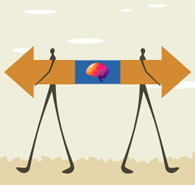Archive for the ‘Professional Issues’ Category
Monday, August 14th, 2017

A recent article in the NY Review of Books covers an ongoing controversy about the major differences in an early version of King Lear and the later version, the First Folio. The book under review makes the case for a definitive version that has gone missing.
(more…)
Posted in Commentary, Neurofeedback, Professional Issues | No Comments »
Wednesday, November 12th, 2014
by Siegfried Othmer, PhD

M y own theme at the conference was the common core of biofeedback and neurofeedback. This has actually been a recurring theme. This was a topic that I had covered back in 2006 at this same conference, which was also held in Northern California. At that time the talk was part of a multi-ring circus, and the only folks in attendance were neurofeedback people. The attempt to heal the breach between the two disciplines had not found its audience. By now, of course, the terrain is very different, at least at the conceptual level, if not at the level of practice. Most of the older biofeedback practitioners are sticking with their knitting, as far as I can tell. Change is being introduced with the new people entering the field, most of whom are no doubt being attracted by the greater glamour, and the bracing challenge, of brain training.
(more…)
Posted in Biofeedback, Conferences, Professional Issues | No Comments »
Wednesday, November 12th, 2014
by Siegfried Othmer, PhD

G eorge Fuller von Bozzay spoke about new developments in the area of wearables, apps, and other consumer-oriented devices. As it happens, he has himself been involved in one of these developments in the past. One of his neighbors is (or was) Ryan Gordon of Atari fame, and at a time when he was looking for projects he became intrigued with George Fuller’s idea for the development of video feedback for a GSR signal. Gordon insisted, however, that it be in the form of a game, and thus emerged the first such product, “Mind Drive.”
(more…)
Posted in Biofeedback, Conferences, Professional Issues | 2 Comments »
Friday, September 12th, 2014
by Siegfried Othmer, PhD

A t the time of the storming of the Bastille in 1789, King Louis the 16th wrote in his private journal: “Rien.” Nothing. Just a few years later, he was beheaded and himself came to nothing. One could make similar judgments about our field. No one in the suites at Pfizer is quaking in his boots at the contemplation of our ascendancy. We don’t yet count for very much. But biofeedback and neurofeedback are gradually marbling into the mainstream. The scientific foundations are being shored up; the techniques are being refined; the products are becoming ever more competent, as well as more attractive in their features; and the methods are becoming more people-friendly. Most importantly, the scope of what we can now accomplish with our methods is expanding to cover the entire realm of mental health. At the moment, the contrast between the actual prospects of self-regulation-based therapies, and the awareness prevailing in the rest of the world about their potential, could hardly be greater.
(more…)
Posted in Application of Neurofeedback, Commentary, Neurofeedback, Professional Issues | 2 Comments »
Thursday, February 2nd, 2012
 This newsletter was first published in NeuroConnections, the joint publication of the AAPB and ISNR, Winter 2011 This newsletter was first published in NeuroConnections, the joint publication of the AAPB and ISNR, Winter 2011
This year’s ISNR meeting seemed to have more invited speakers who were comfortable talking neurofeedback. In the past, one had the feeling that some presenters were there mainly to collect their speaking fees, and were not really prepared to engage with us on our core assumptions. There is a rising tide in the neurosciences that is lifting all boats, even ours. The conversation is shifting toward a language of networks, of structural and functional connectivity, as the key issue in psychopathology, and toward neuromodulation as a strategy for functional recovery. And there we are, having occupied that space already for some decades.
(more…)
Posted in Application of Neurofeedback, Conferences, Neurofeedback, Professional Issues, Scientific | No Comments »
Thursday, February 2nd, 2012
 The field of neurofeedback has found itself subject to conflicting forces over the past decades, and it may be helpful to articulate some of the key factors that are driving our evolution as a discipline. On the one hand, we are subject to the constraints of a health care practitioner guild, and on the other we find ourselves in the much more uncertain terrain of frontier science. The demands of both are in essential conflict. The practitioner guild must represent to the world that a coherent system of practice exists, one grounded hopefully on a coherent model that is subscribed to by all of the practitioners. Guidelines and standards of practice likely follow to clarify for practitioners the choices that have been made for the sake of a credibly defensible public posture. The field of neurofeedback has found itself subject to conflicting forces over the past decades, and it may be helpful to articulate some of the key factors that are driving our evolution as a discipline. On the one hand, we are subject to the constraints of a health care practitioner guild, and on the other we find ourselves in the much more uncertain terrain of frontier science. The demands of both are in essential conflict. The practitioner guild must represent to the world that a coherent system of practice exists, one grounded hopefully on a coherent model that is subscribed to by all of the practitioners. Guidelines and standards of practice likely follow to clarify for practitioners the choices that have been made for the sake of a credibly defensible public posture.
On the other side we have the practical realities of frontier science, acknowledging that we are just beginning to understand the very powerful tool that we have at our disposal. The original hope (which I shared at the outset) was that a simple set of protocols derived from the original Sterman/Lubar research would serve our collective purposes. These simply needed to be pushed forward into general practice, while being subject merely to some subtle refinements. Our original NeuroCybernetics system was designed with very little flexibility because we did not see a need for it. This simple world view has had to be jettisoned.
(more…)
Posted in Application of Neurofeedback, Biofeedback, Clinical Methods, Neurofeedback, Professional Issues | 8 Comments »
|
|
Subscribe to Email Newsletter
The EEG Info Newsletter circulates via email at least once a month. A variety of topics related to the Neurofeedback / EEG Biofeedback field are covered in over 200 articles.
|




 This newsletter was first published in NeuroConnections, the joint publication of the AAPB and ISNR, Winter 2011
This newsletter was first published in NeuroConnections, the joint publication of the AAPB and ISNR, Winter 2011 The field of neurofeedback has found itself subject to conflicting forces over the past decades, and it may be helpful to articulate some of the key factors that are driving our evolution as a discipline. On the one hand, we are subject to the constraints of a health care practitioner guild, and on the other we find ourselves in the much more uncertain terrain of frontier science. The demands of both are in essential conflict. The practitioner guild must represent to the world that a coherent system of practice exists, one grounded hopefully on a coherent model that is subscribed to by all of the practitioners. Guidelines and standards of practice likely follow to clarify for practitioners the choices that have been made for the sake of a credibly defensible public posture.
The field of neurofeedback has found itself subject to conflicting forces over the past decades, and it may be helpful to articulate some of the key factors that are driving our evolution as a discipline. On the one hand, we are subject to the constraints of a health care practitioner guild, and on the other we find ourselves in the much more uncertain terrain of frontier science. The demands of both are in essential conflict. The practitioner guild must represent to the world that a coherent system of practice exists, one grounded hopefully on a coherent model that is subscribed to by all of the practitioners. Guidelines and standards of practice likely follow to clarify for practitioners the choices that have been made for the sake of a credibly defensible public posture.
On King Lear and Peacocks
Monday, August 14th, 2017A recent article in the NY Review of Books covers an ongoing controversy about the major differences in an early version of King Lear and the later version, the First Folio. The book under review makes the case for a definitive version that has gone missing.
(more…)
Posted in Commentary, Neurofeedback, Professional Issues | No Comments »